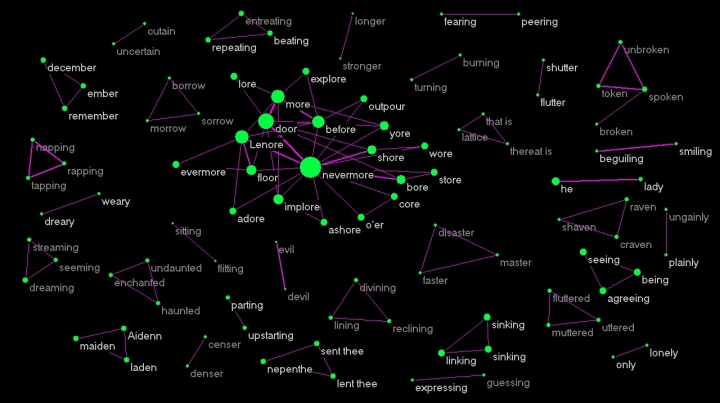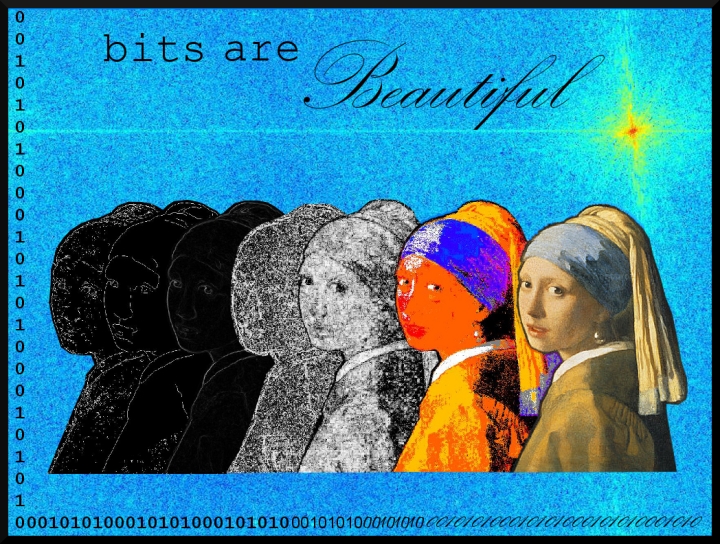Network Models of Rhyme: The Raven
During a digital humanities seminar at Washington & Jefferson College, a colleague, Jennifer Harding, asked me the following question:
“Have you ever seen graph theory applied to poetry? Ever since I learned about graphs, I’ve thought that “The Raven” by Edgar Allan Poe would make a beautiful graph if such a thing were possible….Is this the kind of thing that would lend itself to a graph?”
After contemplating the question for a while, I tried to model the rhyme scheme with the following rules:
1) nodes represent words;
2) we draw a link between two words when a) the words rhyme and b) the words are in the same stanza.
3) if two words meet the criteria specified in step 2 in more than one stanza, then we increment the weight on the link connecting those words.
The application of these rules to “The Raven” produces the following graph.
This graph highlights some interesting things:
1) “nevermore” is located in the largest component;
2) “nevermore” has the highest degree centrality.
In his Philosophy of Composition, Poe claims to be looking for “some pivot upon which the whole structure might turn.” He later concludes that this word should be “Nevermore”.
Our model has essentially captured the role of “Nevermore” as the pivot upon which the poem’s structure turns.
This exercise served as a tutorial in network modeling for the digital humanities seminar at Washington & Jefferson College. Moreover, the tutorial was extended for a digital humanities course to explore the possibility of using network models to test hypotheses in the humanities and arts.
If you find this post interesting, then be sure to check out THATCamp Pittsburgh on October 5th and 6th at Chatham University.
Bits are Beautiful: The Girl with a Pearl Earring
Vermeer’s masterpiece is currently in the United States. In honor of the “Dutch Mona Lisa”, I’ve prepared this image comprising seven transformations of the Girl with the Pearl Earring.
The blue background including the star burst is the fast Fourier transformation of the Girl with a Pearl Earring. Then from left to right the transformations are: Sobel edges, Canny edges, gradient edges, block variation of local correlation coefficients, block difference of inverse probabilities, and a spatial chromatic histogram. Finally, of course, we have the original image.
I created these transformations for a dissertation in digital image processing completed in 2005. The project aimed to extract features from paintings for the purpose of describing artistic style. Although I don’t work in this area much anymore, I always loved the project and these images in particular.
If you think that this is interesting, please consider attending THATCamp Pittsburgh on October 5th-6th, 2013. For more details, please visit the following website: http://pittsburgh2013.thatcamp.org/
Also, please take this opportunity to see Vermeer’s spectacular work. You can read more about where to see The Girl with a Pearl Earring on these sites:
The Mauritshuis Gallery, Collection on Tour: http://www.mauritshuis.nl/index.aspx?chapterID=9017
Carol Vogel, “A Venerable Fresh Face Goes on Tour,” New York Times, January 26th, 2012: http://www.nytimes.com/2012/01/27/arts/design/vermeers-girl-with-a-pearl-earring-to-visit-frick-in-2013.html?pagewanted=all&_r=0
The Communion of the Saints: Networks and Iconography
Co-occurrence Network of Saints in Early Images of Saint Francis
The Communion of the Saints presents a view of the Christian community that spans space, time, life, and death. Medieval iconography captures the evolution of the Communion by integrating new Saints into established iconographic imagery. The co-occurrences of Saints in medieval paintings provide a basis for modeling the development of iconography as a network. This study adapts techniques for analyzing groups of people in digital images to the images of Saints in medieval paintings. In the development of the iconography of St. Francis in the thirteenth and fourteenth centuries artists and their patrons exerted great effort to connect St. Francis to the rich iconographic tradition of the Middle Ages. The network of early images of St. Francis exhibits characteristics consistent with networks that develop by preferential attachment whereby the network evolves by attaching new nodes (recently canonized Saints) to those nodes with high degree. Accordingly, Christ, Mary, and Francis are hubs with high degree, and the degree distribution of the nodes fits that of a power-law distribution. The evolution of this structure, driven by the imagery of intercession, creates a dense network of closed triads arranged hierarchically from Christ to Mary to Francis to the broader community of Saints. By examining the evolution of the network, researchers can analyze and visualize the changing structure of the Communion of the Saints and its associated iconographic traditions.
This paper will be presented at the Arts, Humanities & Complex Networks 2013 Conference in June.
Conference Website: http://artshumanities.netsci2013.net/
Abstract: http://csis.pace.edu/~lombardi/p/icon/
Dangerous Liaisons: Epistolary Structure and Plot Analysis
I’m currently working on a paper, “Dangerous Liaisons: Epistolary Structure and Plot Analysis,” for the NetSci2013 Conference. Read the abstract: http://csis.pace.edu/~lombardi/p/dl/
Introduction
This is my first post. I don’t really know what to write.
You can be sure, however, that in the future this blog will be engaging.
Hello world!
Welcome to WordPress.com. This is your first post. Edit or delete it and start blogging!



leave a comment